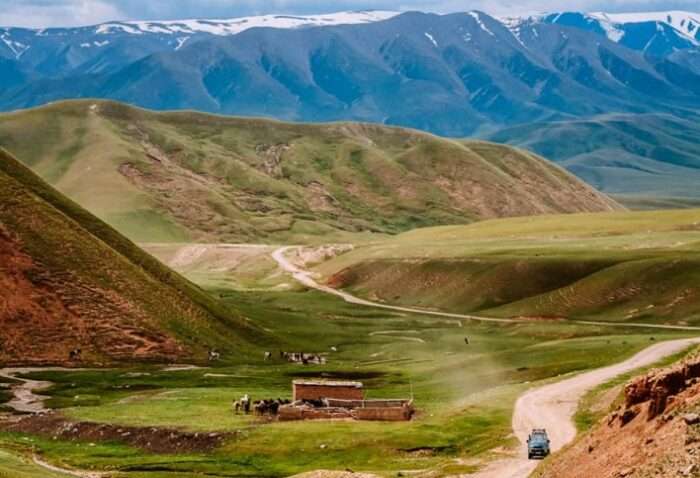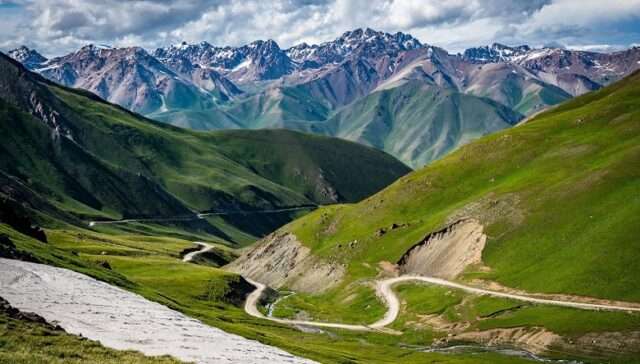Neither a physical road nor a singular path, the Silk Road does not exist. The Silk Road was a historic trading route that connected Asia, the Middle East, and the West. Between the Roman Empire and China, and later between mediaeval European countries and China, it served as a vital commerce route. Silk Road – World’s 8th Extravaganza is one of the tourist place in Pakistan.
Instead, the phrase refers to a system of trade routes that have been in existence for more than 1,500 years. Its length of more than 6,400 kilometers was crucial in promoting East-West exchanges in terms of politics, religion, and culture. The term “Silk Road,” which was first used in the late 19th century, has fallen out of favour with some contemporary historians in favour of the term “Silk Routes,” which more accurately describes the complex network of land and sea routes linking East and Southeast Asia, the Indian subcontinent, Central Asia, the Middle East, East Africa, and Europe.
The name “Silk Road” refers to the very profitable commerce in silk textiles, which were virtually exclusively made in China. Around 114 BCE, the Han dynasty expanded into Central Asia, largely pacifying the once unruly region and this is when the network first emerged.
Hunza Valley: A Scenic Beauty of Pakistan
Zhang Qian, an imperial envoy, was given the job to scout out uncharted territory outside the area in search of possible friends and commercial partners. Chinese interest was aroused by the knowledge and products brought back by these trips, which led to official diplomatic and commercial missions as well as attempts to fortify the passages with soldiers and an extension of the Great Wall.
Multiple paths made up the Silk Road. The overland, transcontinental Silk Road split into northern and southern routes as it continued west from the historic trade hubs of China, avoiding the Taklamakan Desert and Lop Nur. The “relay trade” that was practised by merchants along these routes saw items changing “hands numerous times before reaching their final destinations.”
In addition to tangible products, one of the main exports from the West along the Silk Road was religion. Early Assyrian Christians spread their religion to China and Central Asia, while traders from the Indian subcontinent introduced Buddhism to China. The Silk Road was also a path of disease. Many academics concur that the Black Death epidemic in the middle of the fourteenth century was brought about by the bubonic plague being imported from Asia to Europe.
History
In the first and second century B.C., commercial channels between Greece and China started to open. The Kushan Empire, which dominated land in what, is now northern India, and the Roman Empire benefited from the trade brought about by the Silk Road.

It’s interesting to note that Seres, the old Greek word for China, literally means “the land of silk.” Silk Road – World’s 8th Extravaganza is one of the tourist place in Pakistan.
Despite this clear connection to the name, Ferdinand von Richthofen, a German geographer and historian, was the first to adopt the phrase “Silk Road” to refer to the trade routes in 1877. The phrase “Silk Routes,” which better captures the idea that there were multiple thoroughfares, is now used by historians.
The trading posts, markets, and thoroughfares along the Silk Road routes were widely dispersed and well-planned to facilitate easy movement of products during travel, exchange, distribution, and storage.
Routes connected Ctesiphon, the capital of the Parthians, and Seleucia on the Tigris River, a Mesopotamian city in contemporary Iraq, with the Greco-Roman metropolis of Antioch across the Syrian Desert via Palmyra.The cities of Ecbatana (Iran) and Merv (Turkmenistan), from which further routes flowed to modern-day Afghanistan and eastward into Mongolia and China, were reached from Seleucia by roads that travelled through the Zagros Mountains in the east.
Kalat Meeri Fort – A Grandeur of Turbat
The Tigris and Euphrates rivers were used to move commodities up the Silk Road, as were ports on the Persian Gulf. These towns’ routes also led to Mediterranean Sea ports, from which goods were transported to settlements all around the Roman Empire and into Europe.
Goods Import and Export
Although a wide variety of goods were transported over the Silk Road’s network of trade routes, the name derives from Chinese silk’s popularity in the west, particularly with Rome. The Silk Road routes extended from China via India, Asia Minor, Mesopotamia, up through Africa, Greece, Rome, and Britain before ending in Egypt.
The goods that were moved back and forth on the Silk Road are mentioned by Polo and later by von Richthofen. Silk Road – World’s 8th Extravaganza is one of the tourist place in Pakistan.
These items travel from West to East and include: Horses, Saddles and Horse Equipment, Grapes and the grapevine, dogs and other pets, both domestic and exotic, Furs and skins of animals, Honey \sFruits, Glassware, Woolen rugs, carpets, and blankets, Textiles (such as curtains), Silver and Gold Camels, Slaves, Armor and weapons.
These items were shipped from East to West: Silk, Tea, Dyes, Precious Stones, China (plates, bowls, cups, vases), Porcelain, Spices (such as cinnamon and ginger), Bronze and gold artifacts, Medicine, Perfumes, Ivory, Rice, Paper, Gunpowder
Legacy of Silk Route
The Silk Road was most valuable for its cultural exchange. Together these trade routes, every aspect of civilization including art, religion, philosophy, technology, language, science, and architecture was shared along with the goods that merchants transported from one nation to the next. The spread of the bubonic plague, which is assumed to have reached Constantinople along the Silk Road and devastated the Byzantine Empire in 542 CE, is proof that disease migrated along this network.
Due to the closure of the Silk Road, traders were compelled to conduct their business on the sea, which ushered in the Age of Discovery and the emergence of a global community. In its time, the Silk Road helped people learn more about the world they were living in. Its closure would spur Europeans to explore and eventually conquer the so-called New World of the Americas, starting the so-called Columbian Exchange, which passed goods and values between the Old World and the New World, always to the detriment of the New World’s indigenous people. In this way, it is possible to say that the Silk Road laid the foundation for the growth of the contemporary world.
Tourism
The historical Silk Road was a lengthy tourist route that connected numerous Chinese cities, most of which were in northwest China. Silk Road – World’s 8th Extravaganza is one of the tourist place in Pakistan and China.
A number of trading posts and markets along the road were utilised for the storage, transportation, and exchange of products. The Silk Road was another name for it. The majority of the time, guesthouses or inns were separated by one day’s worth of travel for travellers who used camel or horse caravans.










